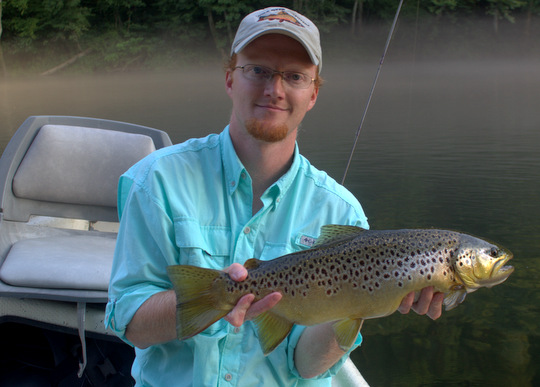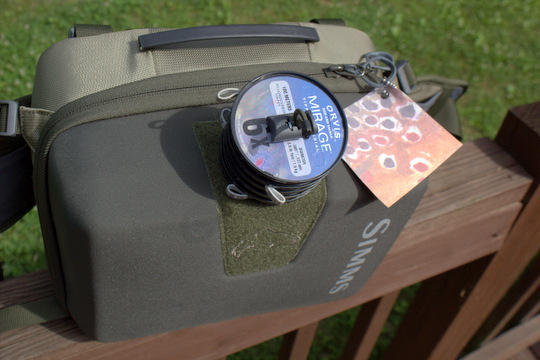 |
| Nathan's 16" Caney Fork brown trout. Photo credit, Nathan Stanaway. |
Life rarely turns out as we planned. Jobs come and go and so do friendships unfortunately. Family is a bit more of a constant although even then we have no guarantees unfortunately. Many surprising twists and turns have come along for me through the years, some of which have been great while others are best forgotten. Earlier this week, a rather unusual change of plans was forced upon me that I did not particularly like, at least not initially. I never dreamed that it would lead to a great Caney Fork brown trout.
This story, like most, needs some background information. My cousin Nathan, who is one of my oldest and best fishing buddies, had made plans to bring his father-in-law Frank up to fish the Caney Fork with me for a couple of days. The trip was all about relaxing and having fun. After last summer's fishing extravaganza that saw a fantastic Caney Fork brown trout caught on a hopper, Nathan was eager to get back out on the river. This time we wouldn't follow up the float with camping in the Smokies but would make the most of our time floating.
For day one, generation was scheduled to start early so we planned on a late day trip to catch the falling water. Originally, when we checked the generation forecast on Sunday, the plan was to run from 9:00 a.m. until 3:00 p.m. That would be perfect to get out on the water and float down the river with just enough extra water in the river to keep us moving. We dumped the boat in around 2:30 p.m. to try and get downstream a bit before the water cut off and then leisurely drifted and messed around with some larger flies. By the time the generation was supposed to cut off, we were right where I wanted to be. The only problem was that the water just kept on coming.
We continued to float and I tried some streamers which brought one Caney Fork brown trout to the boat and showed me some much larger fish. A bit further downstream, I finally made the decision to head for a bank and anchor up. Surely they would cut off the water soon. A quick check of the generation schedule told us that the cutoff time was pushed back to 4:00 p.m. Okay, no problem, we could wait a bit. You guessed it, four o'clock came and went with the water still rushing downstream. Finally, I apologized to the guys and said that we really needed to keep moving unfortunately. Streamers were strung up on the 5 weight Orvis Helios we had brought for dry fly and nymph presentations and we started drifting.
At one point, we switched over to some nymphs and promptly caught a couple of trout but overall things were very slow. The forced change of plans was not looking particularly great and we were already anticipating the next day's trip on lower water. Finally, late in the float, I handed Nathan the streamer rod and instructed him on exactly where and how to fish it. That's when the madness started. Within just a short distance, he soon nailed two very nice trout on my PB&J streamer. The coolest thing about both is that he saw the streamer eats very clearly which is about as much fun as you can have with a fly rod. The 17 inch rainbow and 16 inch brown trout were Nathan's first ever streamer fish so you can imagine how happy he wa
 |
| Nathan's 17 inch Caney Fork rainbow trout |
 |
| Nathan's 16 inch streamer eating Caney Fork brown trout |
 |
| David Knapp's PB&J Streamer does a fantastic job of imitating a shad |
After the second nice fish, a 16 inch brown trout, Nathan asked if I wanted to give it a shot. "Of course," was my answer. He had barely settled behind the oars when a large swirl appeared downstream and to our right. "Do you want me to row over there?" Again, I responded with "of course." On the very first cast, my fly had barely hit the water when a big chunk of golden brown was all over the fly and my 5 weight Helios was immediately being pushed harder than I had imagined would happen on this float.
Before the stress levels got too high on the boat, Nathan slipped the net under the big Caney Fork brown trout, and I let out an ecstatic whoop that probably could be heard all the way downstream to the Cumberland. The fish stretched to 21 inches on the tape on the side of the boat and is an early candidate for my personal "Fish of the Year 2015."
 |
| My big Caney Fork brown trout that ate a PB&J streamer. Photo credit, Nathan Stanaway. |
The fishing was so good, that I contacted my buddy David Perry about floating with me the next day after the morning low water trip with Nathan and Frank, but more on that next time. The change of plans ended up being the best thing that could have happened. This lesson is definitely more broadly applicable in life...
If I can help you with a guided Caney Fork float trip or a guided Smoky Mountain fly fishing trip, please contact me via call or text at (931) 261-1884 or email me at TroutZoneAnglers@gmail.com. I have some days open right now in the upcoming weeks so contact me soon about getting a chance at a big Caney Fork brown trout.
 |
| Releasing Nathan's fine Caney Fork brown trout. Photo credit, Nathan Stanaway. |













































